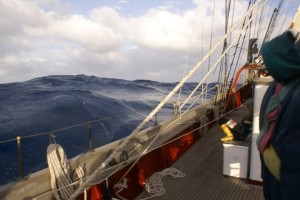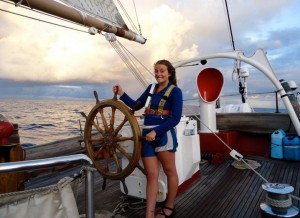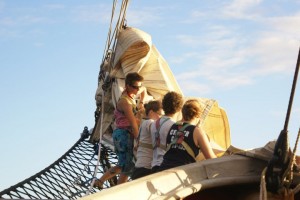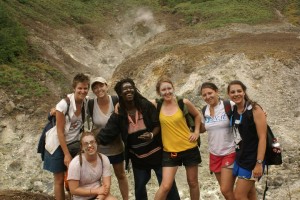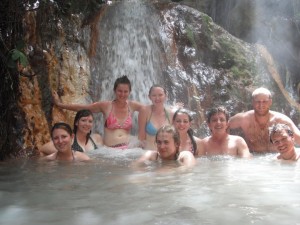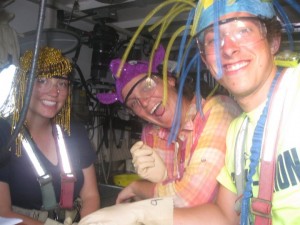I think we should take a moment to reflect on all the badass stuff I did on a boat. I should also probably mention the five-day storm that left us hove-to and clinging to our lives for the greater part of a week.
Badass Thing #1: I didn’t see land for four weeks. Standing on the rising and falling bow of our grand ship, I would look back and marvel at its size. It was freaking tiny. Steering this beast was both empowering and belittling, depending on your perspective. On one hand, I was standing at the wheel of a square-rigged tall ship determining her course across the majestic Atlantic ocean. BA. On the other, I was five and a half feet of organism fighting my way across a relatively boundless expanse using a fragile and finite attempt at a shelter-craft which could be effortlessly demolished and forgotten by its surrounding environment. In general, I preferred to focus on the first perspective.
Badass Thing #2. I sailed us out of a five-day storm. By about the middle of the trip, students took command of the ship’s business. During each watch, one student took charge of the deck as the Junior Watch Officer (J-WO), and another of the lab as the Junior Lab Officer (J-LO). The J-WO was responsible for all of the making the boat do what we wanted and needed, including navigation, traffic, setting, striking, and trimming sail, etc. The J-LO was responsible for all scientific deployments and data processing. So, for a few brief periods, I was calling the shots aboard the Cramer. I got to shout, “hands to set the ____,” and “hands to strike the ____,” and “on your braces, let go and haul!” and all those good things. My most exciting experience as J-WO came when I got to set the first sail after five days parked.
Also right around the middle of the trip, we experienced a weather phenomenon that plopped a stationary high pressure system right on top of us for five days, meaning persistent winds of up to 35 knots and seas up to 16 feet. This was a difficult time in the trip. You couldn’t walk because you couldn’t stand up. You couldn’t sleep because you couldn’t lie still. You couldn’t eat because the waves keeled the boat over farther than the gimballed tables could correct and dishes flew off the tables and all over the sole (floor). We couldn’t even have field day. It was serious. At the beginning of this “storm” we simply struck most of the sails and lashed the rudder hard left so that we were “hove-to”, which pretty much means “parked”. They rigged up the “student strainer” and additional safety lines to ensure that all humans remained aboard the boat.
I was the J-WO to down-rig the safety lines and set the mains’l and jib and sail us out at the end of those five days of hell (and by that I mean I was the one to give the orders to other people to do all those things). It was a very satisfying and cathartic experience.

I'm up at the course yard (the top thing perpendicular to the mast, from which a sail (the course) would hang) non the left.
Badass Thing #3: Furling sails on the bowsprit and aloft. The bowsprit is the pointy thing at the front (bow) of the ship that sticks out beyond the deck, holding the big wire (stay) to which the front sails (jib and jib tops’l) attach. Climbing out on the net underlying the bowsprit was called “laying on the headrig” and was one of my favorite activities. As the bow dipped toward the water, just a net between you and the sea (and certain death since you would be instantly crushed beneath the hull of the ship if you fell in), the feeling was exhilarating. It was especially cool to watch flying fish from the bowsprit, as they glided and bounced in flocks (well, schools) over the surface.
Being on the bowsprit in the rain was also always a good time. Squalls descend suddenly in the tropics, and bursting onto the headrig to wrestle down a sail in a downpour was probably one of my favorite things. I might have yelled “now THIS is sailing!” the first time it happened.
I also had the opportunity to go aloft to furl the squares’ls (which just means ‘square sails’, the square ones on the foremast). I climbed up the shrouds (the rope ladder-looking things along the outside of the rigging), then shimmied over to the mast. There I clung to the mast ladder rungs with a few limbs and beat the crap out of the sails with my remaining limbs. Sails are made of a rather stiff material and require significant force to finagle and furl. I was up there for over an hour on my first time aloft, and I have to admit every muscle in my body was a bit tense by the time I descended. I’m not one to be afraid of heights, but it takes a certain amount of effort to remain attached to a 1-foot wrung 50 feet in the air and get anything done.
Badass Thing #4: After four weeks of not walking more than about 70 feet at a time, I went on a twelve-mile hike through the rainforest mountains of Dominica. “Fat Kids at the Back of the Pack” was the song I composed that day. But really it was quite enjoyable.
Our trek took us through The Valley of Desolation, named for its boiling sulfur and lava vents, and ended at one of the two boiling sulfur lakes in the world. It smelled bad, but it was beautiful. Along the way, our guide smeared lava paste on our faces, let us bathe in some hotsprings, and took us to swim in a cold-water cave system with a waterfall jumping pool. It was pretty badass.
Badass Thing #5. Titrating for oxygen levels. On a boat. Enough said.
Note: aboard the Cramer they call titrating “Winkling” and it requires “winkle gear”.

